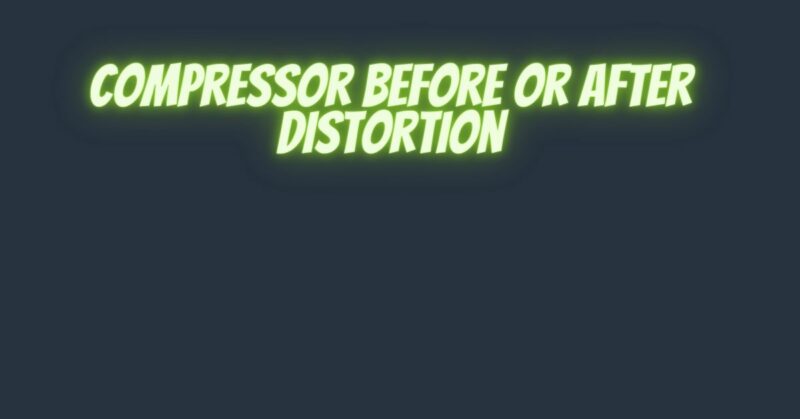Compressors and distortion pedals are two essential pedals for many guitarists. Compressors can help to even out the dynamic range of a guitar signal, making it sound more consistent. Distortion pedals can add gain and distortion to a guitar signal, making it sound more aggressive.
There is no right or wrong answer to the question of whether to use a compressor before or after a distortion pedal. It depends on your specific needs and preferences.
Compressor Before Distortion
Some guitarists prefer to use a compressor before a distortion pedal. This can help to ensure that the distortion pedal is getting a consistent signal, which can make it easier to get the desired sound. Additionally, the compression can help to reduce the noise floor, which can make it easier to hear the distortion’s signal.
Here are some of the pros of using a compressor before a distortion pedal:
- The compressor can help to even out the dynamic range of the guitar signal, making it sound more consistent. This can be helpful if you are using a distortion pedal with a lot of gain, as it can help to prevent the distortion from being too sensitive to your picking dynamics.
- The compressor can help to reduce the noise floor, which can make it easier to hear the distortion’s signal. This can be helpful if you are playing in a noisy environment.
- The compressor can help to add sustain to the guitar signal, which can be helpful if you are playing lead guitar.
However, there are also some potential drawbacks to using a compressor before a distortion pedal:
- The compressor can make the distortion pedal less responsive. This is because the compressor will be compressing the signal before it reaches the distortion pedal, which can make it more difficult to get the desired sound.
- The compressor can make the distortion pedal less transparent. This is because the compressor will be adding its own tonal characteristics to the signal, which can make it more difficult to hear the original sound of the guitar.
Compressor After Distortion
Other guitarists prefer to use a compressor after a distortion pedal. This can help to ensure that the compressor is only affecting the signal that has already been distorted by the distortion pedal. Additionally, the compression can help to add sustain and even out the sound of the guitar signal.
Here are some of the pros of using a compressor after a distortion pedal:
- The compressor can help to even out the dynamic range of the distorted signal, making it sound more consistent. This can be helpful if you are playing with a lot of different dynamics, as it will help to prevent the distortion from being overwhelmed by the loud parts of your signal.
- The compressor can help to add sustain to the distorted signal, which can be helpful if you are playing lead guitar.
- The compressor can help to make the distorted signal sound more even and less harsh.
However, there are also some potential drawbacks to using a compressor after a distortion pedal:
- The compressor can make the distorted signal less responsive. This is because the compressor will be compressing the signal after it has passed through the distortion pedal, which can make it more difficult to get the desired sound.
- The compressor can make the distorted signal less transparent. This is because the compressor will be adding its own tonal characteristics to the signal, which can make it more difficult to hear the original sound of the guitar.
Which Approach is Best?
The best approach to using a compressor before or after a distortion pedal depends on your specific needs and preferences. If you are looking for a consistent signal and a more transparent sound, then you may want to consider using a compressor after the distortion pedal. However, if you are looking for a more aggressive sound with added sustain, then you may want to consider using a compressor before the distortion pedal.
Ultimately, the best way to find out which approach is best for you is to experiment with both and see which one you prefer.
Here are some additional tips for using a compressor with a distortion pedal:
- Use a high-quality compressor pedal. A good compressor pedal will give you more control over the sound of the compression.
- Start with a small amount of compression. It is easy to overdo it with compression, so it is a good idea to start with a small amount and then adjust it as needed.
- Listen carefully to the results. As you are compressing the sound, listen carefully to the results and make sure that you are getting the desired sound.
- Don’t be afraid to experiment. The best way to find the right compressor settings is to experiment with different settings and see what sounds good to you.

